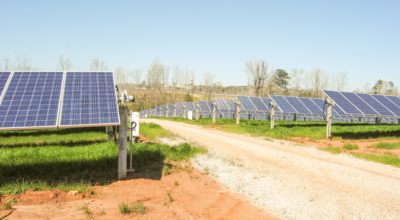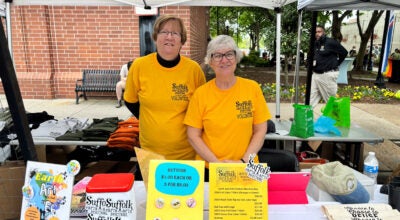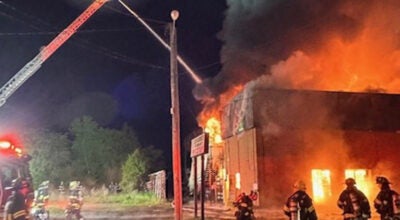Bowers Hill ‘mixing bowl’ plan gets mixed reviews from transportation secretary
Published 6:22 pm Friday, June 24, 2022
|
Getting your Trinity Audio player ready...
|
Region and state transportation officials faced sharp questioning from the state’s transportation secretary over the proposed $2 billion Bowers Hill interchange project and its choice of plan to improve it.
Virginia Department of Transportation officials speaking at the Commonwealth Transportation Board meeting Tuesday outlined their recommendation for an additional toll lane and a part-time driveable shoulder lane to be added in each direction of Interstate 664 from Bowers Hill to College Drive to reduce congestion, increase travel reliability in the area and provide more travel choices. It also has less impact on wetlands, according to VDOT and other transportation officials. This choice would include interchange improvements.
Additionally, officials noted its cost as being about 6%, or $120 million, cheaper than the one other alternative being considered and would better reduce congestion and improve travel reliability. However, the cost is still close to five times more expensive than estimates provided just three years ago, when it estimated the project to cost about $450 million. In April 2021, a Hampton Roads Planning District Commission document estimated the cost at $528 million.
More recently it had estimated the cost at $1.5 billion, according to a federal government permitting dashboard, but during the board’s meeting, VDOT Environmental Manager Andrew Pike, after being questioned about the difference in cost, estimated the project’s cost to be about $2 billion.
VDOT Environmental Division Director Chris Swanson, in outlining the environmental impact statement for the project, noted that in addition to its preferred alternative, it evaluated two other choices, a no-build alternative as a baseline for other potential choices and another alternative to add two managed lanes in each direction on I-664.
However, state Secretary of Transportation Sheppard “Shep” Miller said the wording of VDOT’s purpose and need for the study of possible interchange improvements “leaves me flat” and said it’s akin to making a decision without the full analysis, and it eliminates the option of general-purpose lanes.
“If you built two new lanes or four new lanes, if you did that, those would address congestion, those would address travel reliability in a huge way,” Miller said. “They may not stay the course … for 20 years. They’re going to fail at some point if traffic continues to increase, if it does, so those would be totally unmanaged and they’d provide those two things, but they don’t check the last box.
“And so when we obviate those from the beginning, when we state the purpose and need, then we’ve taken a whole sector of opportunities, or options, and we’ve put them aside and say, ‘We’re not going to look at those. We’re only going to look at these.’ And that’s just not what I prefer to do, but I’m not the be-all and end-all.”
When the agency used the wording, “provide more travel choices,” Miller said it effectively eliminated other potential options without them receiving an extensive review. Managed lanes, as defined by the Federal Highway Administration, include high-occupancy-vehicle lanes, traditional toll lanes or toll lanes that vary pricing by the amount of congestion on the road.
“Once we did that, we can no longer make an assessment of, do we want a toll lane in there or do we not want a toll lane in there,” Miller said, “because the only way to get additional travel choices, in this context, is to have a managed lane. The analysis that follows after that won’t analyze those things.”
Miller said he would have preferred to have a cost-benefit analysis of all the options before narrowing the scope.
Swanson countered by noting that the managed lanes could support additional choice by allowing buses to use them.
The agency rejected two options to add general-purpose lanes and another option to add collector-distributor lanes at interchanges that separate traffic getting on or off the interstate. It also rejected extending an acceleration lane for I-664 northbound at Bowers Hill and adding a new bus route from downtown Portsmouth to Newport News Shipbuilding, and transit-only improvements.
The project has been targeted for funding as a priority project in the Hampton Roads region’s 2045 long-range transportation plan. The Bowers Hill area is a key part of the 65 miles of express lanes wrapping around south Hampton Roads and the northern Peninsula, according to Rob Case, the chief transportation engineer for the Hampton Roads Transportation Planning Organization, and is part of the region’s beltway.
The Bowers Hill area, which officials have described as a “mixing bowl,” is where several major highways and roads converge — Interstates 64, 264 and 664, as well as U.S. Route 58 (U.S. Routes 13 and 460 also overlap there) and Jolliff Road. More than 150,000 vehicles move through the area daily.
VDOT began the environmental review process for the interchange in coordination with the Federal Highway Administration in 2018. The study area was expanded two years later to include the stretch of I-664 from Bowers Hill to College Drive — including the interchanges — just before the Monitor-Merrimac Memorial Bridge-Tunnel.
Between the High Rise Bridge expansion, the express lanes addition and the expansion of the Hampton Roads Bridge-Tunnel, more than $5 billion in projects are taking place across south Hampton Roads.
When the bridge expansion is finished next year, Case said it will add the express lanes to Bowers Hill, but then the road will narrow again and traffic will shift back into the general-purpose travel lanes.
“This Bowers Hill project, we look forward to it because it will continue that express lane network,” Case said.
Miller seemed skeptical about how one managed lane and one part-time driveable shoulder lane in each direction would perform better than having two managed lanes in each direction, noting possible issues with safety and confusion for drivers using a more narrow shoulder lane.
“Forget the cost, a part-time drivable shoulder’s going to get you better performance than a managed lane,” Miller asked. “Interesting. I presume the logic is more people are going to use the part-time driveable shoulder because it’s free? They’re not going to use the managed lane?”
Swanson said he believed the part-time shoulder lane managed the peak congestion better.
In a conceptual, worst-case analysis, Swanson said VDOT’s recommendation could lead to it acquiring up to 21 residential or commercial properties for the interchange project, with up to 60 acres of partial acquisitions, 11,356 linear feet of stream impacts and 103 acres of wetlands impacts.
He said its choice “meets the purpose and need while balancing costs and impacts,” and complements the express lane network being built.
Swanson said the U.S. Army Corps of Engineers and the Environmental Protection Agency agree on VDOT’s choice. The region’s transportation planning organization endorsed the choice in May. He said the majority of public comments agreed that the agency’s choice met the purpose and need for the project.
The FHA issued a notice of intent to prepare an environmental impact statement for the Bowers Hill interchange improvements study in February, which started the National Environmental Policy Act process. NEPA directs federal agencies to conduct environmental reviews to assess possible impacts to the environment when planning projects. The notice included information about the purpose and need for the project, alternatives retained for detailed study and other alternatives that received lesser scrutiny.
VDOT is asking the board to vote on its preferred alternative in July, and by October, the draft environmental impact statement would be available for public review, and a public comment period would take place in either October or November.
By spring 2023, the NEPA review process is expected to be finished and VDOT can move into a more detailed design phase.
Officials have said the project could take another 20 years to complete.






